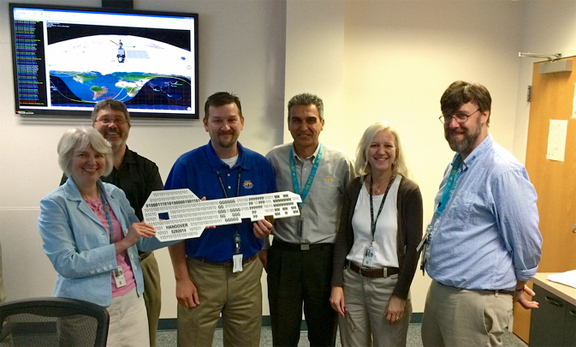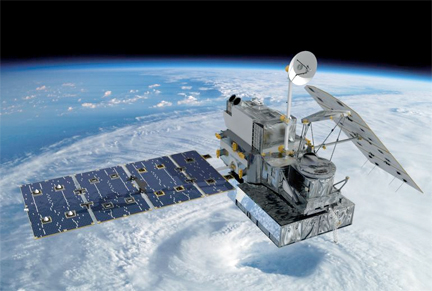
[SatNews] According to the latest information from NASA, the new Global Precipitation Measurement Core Observatory satellite is now in the hands of the engineers who will fly the spacecraft and ensure the steady flow of data on rain and snow for the life of the mission.

On May 29, GPM Deputy Project Manager Candace Carlisle (left) handed over the "key" to the GPM Core Observatory to GPM Mission Director James Pawloski (center, blue shirt). Also pictured, left to right, Wynn Watson, Art Azarbarzin, Gail Skofronick-Jackson and
David Ward.
The official handover to the Earth Science Mission Operations team at NASA’s Goddard Space Flight Center in Greenbelt, Maryland, on May 29th, marked the end of a successful check-out period. The Global Precipitation Measurement (GPM) mission is a joint mission between NASA and the Japan Aerospace Exploration Agency. Its Core Observatory launched on February 27, 2014, from Tanegashima Space Center in Japan. The satellite’s two science instruments collect observations of rainfall and snowfall worldwide. Since launch, the satellite has gone through a thorough check-out of all its systems and reached its final orbit of 253 miles (407 kilometers) above Earth's surface.
"Commissioning has gone very well," said Mission Systems Engineer David Ward of NASA Goddard at GPM's Post-Launch Acceptance Review on May 15. "The issues that have occurred have been relatively minor. We're in very good shape."
The check-out period is like taking a new car out on a road trip—the engineers in the driver's seat learn how it handles and make adjustments to find the "sweet spots" for smooth flying and data collection. In the first weeks after launch the Flight Operations Team at Goddard, supported by the engineers who built the spacecraft, turned on spacecraft systems and ran them through normal procedures. The team turned on both science instruments a few days after launch: the GPM Microwave Imager on March 1, and the Dual-frequency Precipitation Radar on March 2. Two weeks after launch, both instruments were collecting data and the team had begun calibration procedures to ensure that the data returned is as accurate as possible.
"We're doing really well," said Erich Stocker, GPM deputy project scientist and project manager for the Precipitation Processing System at Goddard, which handles data for GPM and its predecessor satellite, the Tropical Rainfall Measuring Mission (TRMM). "GMI is the best calibrated radiometer out of the box that we've ever had. And DPR is well-calibrated for this stage," he said, noting that the instrument can pick up weather elements, like classic thunderstorm anvil-shaped clouds, which TRMM could not.

Artistic rendition of the
Global Precipitation Measurement Core Observatory satellite.
A series of propulsion burns in March and early April took the Core Observatory into its final orbit at 253 miles. At that altitude, however, drag is still a problem—a very thin layer of atmosphere still exists, which can slow down a quickly moving satellite with two extended solar arrays. In LEO, slowing down means losing altitude. To counteract the drag, the thrusters had a planned burn every week to maintain speed and altitude. After evaluating how well the solar arrays were collecting power—very well—the flight team made minute adjustments to the angle of the arrays to reduce drag, reducing the need for altitude maintenance burns to every other week.
Altitude adjustments are one part of the Core Observatory's new routine, which also includes retrieving housekeeping data on the satellite systems and maintaining contact with NASA's communications satellites for speedier data downlinks. And, approximately every 40 days, moving in the same orbit direction, the team flips the spacecraft front-to-back. Due to GPM's inclined orbit 65 degrees from the equator, the spacecraft has a varying angle to the sun. The reversal of its orientation keeps the sun on the appropriate side of the spacecraft and prevents overheating.
Final tweaks and validation of the science data will continue through the summer, and the Precipitation Processing System will continue to streamline its production of multiple kinds of datasets, from the Core Observatory's individual 90-minute orbits to combining data with other satellites into global precipitation maps. GPM data will be available to the public by September 2014.
More information is available at http://www.nasa.gov/mission_pages/GPM/overview/index.html#.U40_wC9upSs

